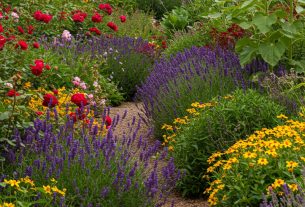As a passionate gardener, I understand the thrill of nurturing a plant, watching it grow, and ultimately enjoying the beauty it brings to our spaces. One of my all-time favorites, the gardenia, with its stunning white blooms and intoxicating fragrance, can be a bit challenging to grow. If you’ve found yourself asking, “Why won’t my gardenia grow?” you’re not alone. This article is here to explore the common issues that can hinder the growth of gardenias and share expert tips and tricks to help you cultivate these delightful plants successfully.
Understanding the Gardenia Plant
Before diving into troubleshooting, it’s essential to understand what makes gardenias unique. Gardenias belong to the Rubiaceae family and are native to tropical and subtropical regions of Africa, Asia, and Australia. These evergreen shrubs can reach heights of 2 to 8 feet and are cherished for their creamy white flowers and glossy green leaves.
Gardenias thrive in acidic, well-draining soil and prefer warm, humid environments. However, they can be finicky and require specific conditions to flourish. Let’s explore the most common reasons why gardenias might struggle to grow in your garden.
Common Reasons Your Gardenia Won’t Grow
Despite my best efforts, I’ve faced my share of gardenia struggles. Here are the main culprits that can hinder your gardenia’s growth:
- Soil Issues: Gardenias prefer acidic soil with a pH between 5.0 and 6.0. If your soil is too alkaline, it can prevent nutrient absorption.
- Improper Watering: Both overwatering and underwatering can lead to root rot or dehydration. Finding the right balance is crucial.
- Insufficient Light: Gardenias require bright, indirect sunlight. Too much direct sunlight can scorch their leaves, while too little can hinder blooming.
- Pests and Diseases: Common pests like aphids and whiteflies can sap the plant’s vitality, while diseases such as root rot can devastate your gardenia.
- Temperature Sensitivity: Gardenias thrive in temperatures between 65°F and 70°F. Exposure to cold drafts or extremes can stress the plant.
- Fertilizer Issues: Over-fertilization can lead to nutrient burn, while under-fertilization can prevent blooming and overall growth.
Soil Solutions: Creating the Perfect Environment
Soil is the foundation of any garden. Based on my experiences, here are some actionable steps to ensure your gardenia has the right soil conditions:
- Test Your Soil: Use a soil pH test kit to determine your soil’s acidity. If it’s above 6.0, consider amending it with sulfur or peat moss to lower the pH.
- Amend with Organic Matter: Incorporate organic matter such as compost or well-rotted manure to improve soil structure and nutrient content.
- Use Well-Draining Soil: Consider a soil mix specifically designed for acid-loving plants. This will promote drainage and prevent root rot.
Watering Wisely: Finding the Right Balance
Watering can be a tricky balance to strike. Here are some tips that have worked for me:
- Check Soil Moisture: Before watering, check the top inch of soil. If it feels dry, it’s time to water. If it’s still moist, hold off.
- Water Deeply: When you do water, ensure you give the plant a deep soak. This encourages deep root growth and helps the plant withstand drought.
- Use Rainwater: If possible, collect rainwater as it is naturally acidic and beneficial for gardenias.
Light Matters: The Right Amount of Sun
Gardenias love light, but too much can damage them. Here’s how to ensure your gardenia gets just the right amount:
- Location, Location, Location: Place your gardenia in a spot that receives bright, indirect sunlight. A south-facing window is often ideal for indoor plants.
- Monitor Light Levels: If you notice leaf scorch or yellowing, it may be a sign of too much direct sunlight. Consider moving it to a shadier spot.
- Provide Humidity: Gardenias love humidity. If you live in a dry climate or during winter months, consider using a humidifier or placing a pebble tray filled with water near the plant.
Pest Control: Keeping Your Gardenia Healthy
Sometimes, pests can sneak up on us. Here’s how I manage pests effectively:
- Regular Inspections: Check your gardenia regularly for signs of pests. Look for sticky residue, discolored leaves, or visible insects.
- Natural Remedies: Use insecticidal soap or neem oil to manage pests organically. Spray in the early morning or late afternoon to avoid leaf burn.
- Encourage Beneficial Insects: Ladybugs and lacewings can help control aphid populations. Planting flowers that attract these beneficial insects can be a great strategy.
Temperature Management: Keeping Your Gardenia Comfortable
Temperature fluctuations can stress gardenias. Here are some strategies I use to maintain a stable environment:
- Avoid Drafts: Keep your gardenia away from heating vents or air conditioning units. Sudden temperature changes can be detrimental.
- Indoor Care: If growing indoors, consider using a thermostat to maintain consistent temperatures.
- Outdoor Placement: If growing outside, plant gardenias in a sheltered location to protect them from harsh winds and extreme cold.
Fertilizing: Feeding Your Gardenia Right
Feeding your gardenia is essential for healthy growth and blooming. Here are my recommendations:
- Choose the Right Fertilizer: Use a fertilizer specifically formulated for acid-loving plants. Look for an NPK ratio of 3-1-2 or 4-1-2.
- Timing is Key: Fertilize in spring as the plant begins to wake up and again in mid-summer. Avoid fertilizing in late fall to prevent stimulating new growth before winter.
- Follow Instructions: Always follow the manufacturer’s instructions for application rates to avoid nutrient burn.
Case Studies: Success Stories from Fellow Gardeners
To further illustrate these tips, let me share a few success stories from fellow gardeners who faced similar challenges:
Case Study 1: Sarah’s Gardenia Revival
Sarah, a gardening enthusiast from Florida, noticed her gardenia was always drooping despite her best efforts. After testing her soil, she discovered it was too alkaline. By amending it with peat moss and adjusting her watering schedule, she saw a remarkable recovery; her gardenia bloomed beautifully within weeks.
Case Study 2: Tom’s Pest Problem
Tom, a dedicated gardener in Texas, struggled with aphids invading his gardenia. He began using neem oil as a natural pesticide and invited ladybugs into his garden. Within a month, the aphid population decreased dramatically, and his gardenia thrived once again.
Frequently Asked Questions (FAQ)
1. Why are the leaves of my gardenia turning yellow?
Yellowing leaves can indicate overwatering, nutrient deficiencies, or poor soil pH. Check your watering habits and test your soil’s pH.
2. How often should I water my gardenia?
Water your gardenia when the top inch of soil feels dry. This typically translates to once every few days during the growing season.
3. Can I grow gardenias indoors?
Yes, gardenias can be grown indoors, but they require bright, indirect sunlight and higher humidity levels. Consider placing a humidifier nearby.
4. What is the best fertilizer for gardenias?
Use a fertilizer formulated for acid-loving plants with an NPK ratio of 3-1-2 or 4-1-2. Always follow the application instructions to avoid over-fertilization.
Conclusion: Cultivating Success with Gardenias
Growing gardenias can be a rewarding yet challenging endeavor. By understanding the specific needs of these beautiful plants—soil requirements, watering practices, light conditions, pest management, temperature control, and proper fertilization—you can significantly increase your chances of success. Remember, gardening is a journey filled with learning experiences, and each challenge presents an opportunity for growth.
If you ever find yourself confused or facing new challenges, don’t hesitate to ask questions or seek advice. I encourage you to sign up for our newsletter for more gardening tips and tricks, and feel free to share this article with friends who might be struggling with their gardenias. Together, we can nurture our gardens and enjoy the beauty that comes with them!
Flexzilla Garden Hose 5/8 in. x 50 ft., Lightweight All-Weather Water Hose, Durable and Flexible, Leak-Free Connections
$28.99 (as of 13/11/2025 03:49 GMT -03:00 - More infoProduct prices and availability are accurate as of the date/time indicated and are subject to change. Any price and availability information displayed on [relevant Amazon Site(s), as applicable] at the time of purchase will apply to the purchase of this product.)
Sign up for our newsletter and stay up to date with exclusive news
that can transform your routine!




